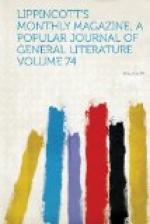all been gathered in, their hard work is done, and
though in a few weeks the old routine will begin again,
they are now oblivious of it all. Hour after
hour they continue to dance, a new array of fresh performers
taking the place of those who are exhausted, and then
the regular beating of their feet on the floor can
be heard at a considerable distance, with a dull,
monotonous sound, varied only by the hum of voices
or noise of laughter or the shrill notes of the musical
instruments. These are the banjo and accordion,
the former being the favorite, perhaps because it is
more intimately associated with the social traditions
of the negroes. Their best performers play very
skilfully on both, and indulge in as much ecstatic
by-play as musicians of the most famous schools.
They throw themselves into many strange contortions
as they touch the strings or keys, swaying from side
to side, or rocking their bodies backward and forward
till the head almost reaches the floor, or leaning
over the instrument and addressing it in caressing
terms. They accompany their playing with their
voices, but their
repertoire is limited to a
few songs, which generally consist in mere repetition
of a few notes. All their airs have been handed
down from remote generations. Their words deal
with the ordinary incidents of the negro’s life,
and embody his narrow hopes and aspirations, but they
are rarely connected narratives. As a rule, they
are broken lines without relevancy or coherence, while
the choruses are so many meaningless syllables.
The negroes seem to derive no pleasure from music
outside of those songs and airs which they have so
often heard at their own hearthstones, and which have
come down to them from their ancestors.
The Christmas holidays, extending from the 25th of
December to the 2d of January, are a period of entire
suspension of labor on the plantation. In anticipation
of their arrival, a large quantity of fire-wood is
hauled from the forests and piled up around the cabins;
but the negroes spend very little of this interval
of leisure in their own homes, unless a bad spell
of weather has set in and continues. They are
either out in the open air or at the “store.”
This latter serves the purpose of a club, and is a
very popular resort. Even at other times of the
year it is always packed at night; but during the
Christmas holidays it is full to overflowing in the
day-time. At this gay season the fires are kept
burning very fiercely; the Sunday suits and dresses
are worn every day; the tables are covered with more
abundant fare of the plainer as well as rarer sort.
All visitors are received with increased hospitality,
and work of every kind that usually goes on in the
precincts of the dwelling is, if possible, deferred
until the opening of the new year. Many strange
faces are now seen on the plantation, and many faces
that were once familiar, but whose owners have removed
elsewhere. The negro is as closely bound in affection
to the scenes of his childhood as the white man, and




